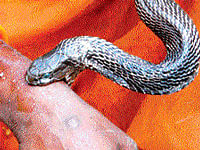
The study estimates that snake bites accounted for 2,400 deaths in Karnataka in 2005, or 4.2 deaths per 1,00,000 population. However, the official figures show only 183 deaths with 5,073 non-fatal snake bite cases in the same year. Karnataka is one of the 13 States with the highest prevalence of snakebite deaths, the study indicates.
Titled ‘Snake bite Mortality in India: A Nationally Representative Mortality Survey’, states that while India is perceived to have more snake bites globally, the numbers of deaths are under-estimated. Interestingly, the annual number of deaths occurring due to snake bites, as per the study, is estimated between 1300 and 50,000 per year in India.
In 6,671 randomly selected places between 2001-03 in India, non-medical field workers interviewed families and found that 562 deaths were caused due to snake bites.
The study revealed that about 97 per cent of snake bite deaths took place in rural areas and 59 per cent of the people who died were males. Around 25 per cent of the deaths were of people between 15-29 years of age and all were bitten in the monsoon months of June to September. Also, only 23 per cent of deaths occurred in hospitals or established medical institutes.
The high rate of snake bite occurrence in rural areas and also consequent mortality is due to snakes seeking prey such as rodents — field mice and frogs in cultivated fields. The maximum number of bites in India are by the saw-scaled viper (echis carinatus). The other venomous snakes in India include Cobra, Russells Viper and the Banded Krait, although in coastal areas sea snakes too account for bites, the mortality rate is low. While India is host to over 60 species of venomous snakes, south-west coast and Western Ghats are home to hump-nosed pit viper.
State situation
Snake bite records with the Health Department show deaths occurring every year, since 1998 (records before that not available).
While 2003 saw the highest number of deaths — 230 — the attacks have only increased year on year, with 2010 seeing 10,384 people being bitten. Interestingly, only 170 people died due to venom the same year, indicating that either anti-venoms were being administered immediately, or that the official figures were an under-estimated account, which drew attention back to the findings made by the study.
Recommendation
The study saw a need to educate the community, providing appropriate training to medical personnel and distributing anti-venom particularly in the 13 States.
Since snake bites lead to one death for every two HIV-related deaths in the country, it is necessary to have effective intervention by providing anti-venoms in all health centres, the study suggested. A surveillance system was needed to be put in place to access the actual burden so that such deaths could be prevented, the study further suggested.